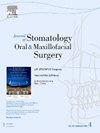Normative data on nasalance scores for French speaking children
IF 1.8
3区 医学
Q2 DENTISTRY, ORAL SURGERY & MEDICINE
Journal of Stomatology Oral and Maxillofacial Surgery
Pub Date : 2024-09-21
DOI:10.1016/j.jormas.2024.102089
引用次数: 0
Abstract
Introduction
The objectives of this study are to establish normative nasalance values in European French for children aged 8–10 years, to study the factors likely to influence nasalance values, and to ensure that the nasometer allows the differentiation of control subjects from subjects with velopharyngeal insufficiency.
Methods
Nasal balance scores were calculated using the Nasometer II 6450 (KayPENTAX) for 50 control subjects producing 31 verbal stimuli specifically designed for the French language. Nasalance scores were analyzed and compared with 7 subjects with velopharyngeal insufficiency.
Results
This study provided nasalance norms for each verbal stimulus. The phonetic content of the stimuli (nasality, vowel height, voicing) was a major factor influencing the nasalance score. However, the characteristics of the speaker (gender and age) had a non-significant effect, with the major exception of the presence or absence of velopharyngeal insufficiency.
Conclusion
This study confirmed the need to use established normative values in the patient's language and for each verbal stimulus. Although the effect of vowel height on the nasalance score has been demonstrated, this study is the first to show an effect of voicing. Once normative nasalance scores are established, a validation study with a larger pathological population will be necessary.
This study establishes normative nasalance scores in European French in children.
法语儿童鼻平衡评分的标准数据。
引言:本研究的目的是为8至10岁的欧洲法语儿童建立鼻平衡标准值,研究可能影响鼻平衡值的因素,并确保鼻平衡测试仪能够区分对照组和发展咽喉功能不全的受试者:方法: 使用鼻腔测量仪 II 6450(KayPENTAX)计算 50 名对照组受试者的鼻腔平衡分数,受试者要发出 31 个专门为法语设计的语言刺激。对鼻平衡得分进行了分析,并与 7 名患有发展性咽喉功能不全的受试者进行了比较:这项研究为每种语言刺激提供了鼻腔平衡标准。刺激物的语音内容(鼻音、元音高低、发声)是影响鼻音平衡得分的主要因素。然而,说话者的特征(性别和年龄)对鼻腔平衡的影响并不显著,有无咽喉发育不全是主要例外:这项研究证实,有必要在患者的语言和每种言语刺激中使用既定的标准值。虽然元音高度对鼻腔平衡评分的影响已经得到证实,但本研究是首次显示发声的影响。一旦确定了标准鼻平衡评分,就有必要对更多病理人群进行验证研究。本研究确定了儿童欧洲法语的标准鼻音平衡分数。
本文章由计算机程序翻译,如有差异,请以英文原文为准。
求助全文
约1分钟内获得全文
求助全文
来源期刊

Journal of Stomatology Oral and Maxillofacial Surgery
Surgery, Dentistry, Oral Surgery and Medicine, Otorhinolaryngology and Facial Plastic Surgery
CiteScore
2.30
自引率
9.10%
发文量
0
审稿时长
23 days
 求助内容:
求助内容: 应助结果提醒方式:
应助结果提醒方式:


